Introduction
Many areas of Florida annually receive between 50 and 60 inches of rainfall (Butson and Prine 1968). However, while the levels of rainfall meet or exceed the annual potential evapotranspiration (ETp) levels of 46 to 56 inches (Smajstrla et al. 1984), the distribution in rainfall and the low water holding characteristics of sandy soils necessitate irrigation of most crops.
Most of the rainfall occurs during the summer months when many seasonal crops are not in production. Also, rainfall events which occur during the growing season often exceed the infiltration capacities of the fields, resulting in surface runoff. Both of these circumstances produce free water which is not utilized for crop production. Ponds can capitalize on this free resource for many benefits, This bulletin discusses the uses of ponds, types, and some procedures for designing and sizing excavated ponds. An appendix contains specific examples to help with the understanding of this material.
Uses of Farm Ponds
The intended use of the pond will be one factor considered in determining the size of a pond. Site selection and available water supply will be other factors discussed later. Ponds may be used in one or several locations to provide water for livestock in pastures. A uniform distribution of ponds would minimize over-grazing in the areas around a particular water site.
Irrigation ponds are generally limited to small production acreage such as some vegetable, strawberry, and nursery operations. The water may be used for crop establishment, seasonal water requirements, cold protection, or water for spray equipment.
Aquaculture, or the production of aquatic foods, is becoming popular in some areas of Florida. Catfish, crawfish, and prawns can be produced in ponds as a commercial operation, or the pond may be used as a private fishing reservoir.
Other uses include fire protection, boating and swimming recreation, a habitat for waterfowl, and watering sites for other wildlife. These uses may be combined for multiple purposes. However, if more than one purpose is intended, the water supply must be adequate to meet all needs and the uses must be compatible. For example, livestock may pollute a pond intended for recreation.
Types of Ponds
Two types of man-made ponds are embankment ponds and excavated ponds. Topography and site conditions generally determine which type of pond will be used.
Embankment ponds (Figure 1) are constructed by forming an earth embankment or dam across a watercourse. These ponds are generally suited to areas where land slopes range from mild to steep and the watercourse is deep enough to impound water at least 6 feet deep at the embankment.
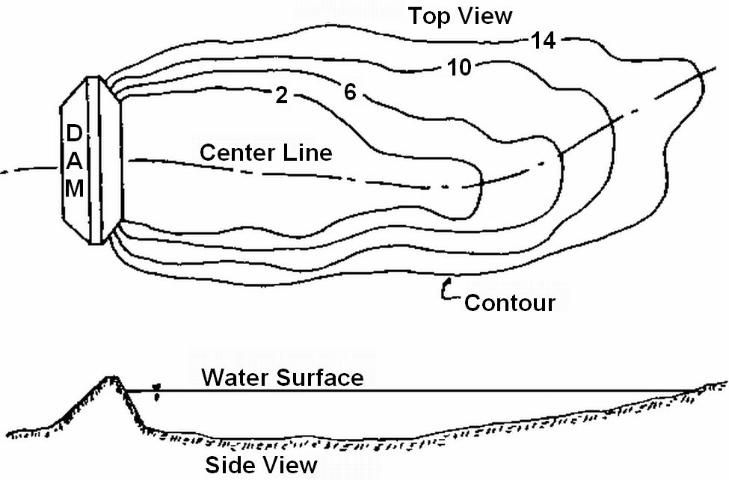
Excavated ponds are constructed by excavating a pit below the normal ground level. These ponds work well in areas which have naturally high water tables. These types of ponds generally require more earth to be moved than embankment ponds for comparable storage. Therefore they are generally used when embankment ponds will not work (Figure 2).
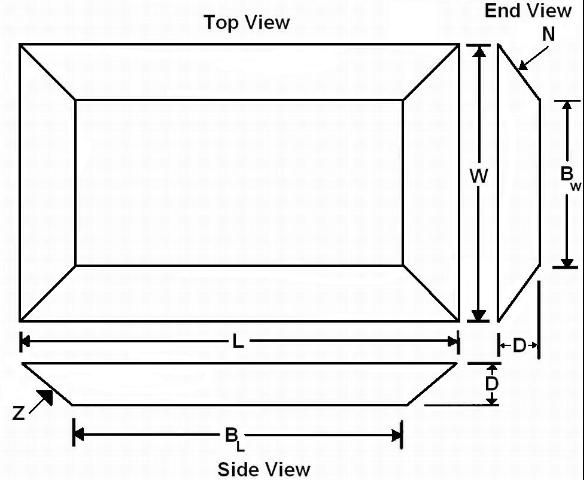
Site Selection
Site selection and placement of the pond are critical to the success of the pond. The water source for the pond may be surface runoff from the pond watershed (the area that drains into the pond) or it may come from subsurface seepage in areas with high water tables.
Size
The size of the pond watershed should be investigated before construction. A watershed which is too large may produce excessive runoff which could cause erosion at the pond site or failure of the embankment of embankment ponds. In these cases excessively large emergency spillways or diversion terraces may need to be constructed to route the excessive runoff away from the pond. If the watershed is too small, the surface runoff may not be sufficient to fill the pond.
The required volume of water depends on the intended use of the pond. (Table 1) provides estimates of livestock water requirements. Figure 3 can be used to convert from gallons to acre-feet of storage.
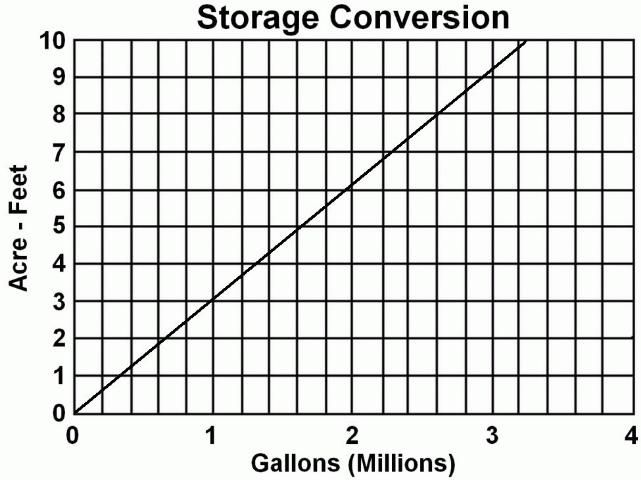
Irrigation requirements depend on several factors such as the length of the growing season, effective rainfall, crop water requirements, application efficiency of the irrigation system, number of acres to be irrigated, and expected inflows into the pond. Florida has high levels of evapotranspiration, therefore sizing a pond to meet annual or seasonal needs may not be feasible. The pond may be sized to provide sufficient storage for a shorter period of time, such as a one or two week period. See the Appendix for specific examples.
Specialty irrigation requirements such as frost and freeze protection, or crop cooling and transplant establishment may have calculable levels of need. Figure 4 can be used to determine the required acre-feet of storage per irrigated acre for continuous operation up to 12 hours. Return flow is defined as the surface runoff from irrigation which returns to the pond. Return flow can be accounted for by subtracting the fraction of expected return flow from the total application. This is useful for cases in which the system is run daily for several days in a row, resulting in a contribution back into the system by surface runoff of irrigation' water. See the Appendix for an example.
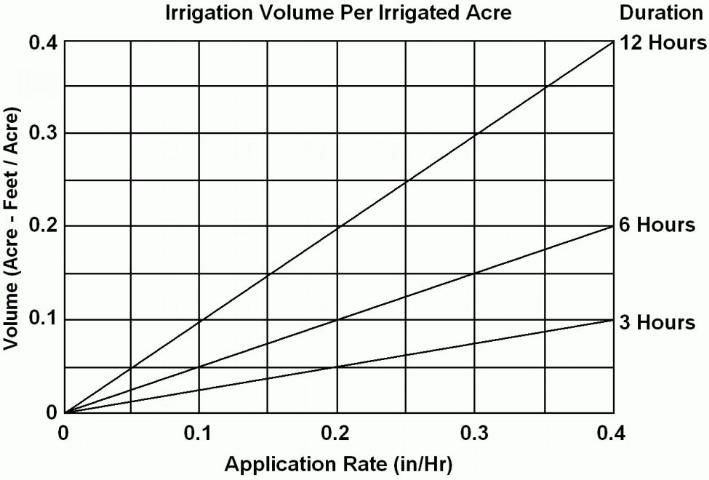
Water requirements for field and orchard spraying are generally small. Field sprayings may require about 100 gallons per acre per spraying. Orchards can require up to 1000 gallons per acre per spraying.
A pond should never be designed to provide just enough water to meet the needs of the system but should have surplus storage to maintain a base of at least 10 percent of full storage.
Location
Factors such as soil characteristics and the existence of local springs must be considered in site selection. A dependable spring may reduce the size of the required watershed for a given size of pond. Conversely, highly permeable soils which are typical in most of Florida, may increase the size of the required watershed for a given pond size. Some ponds may require supplemental recharge from another water source such as a well during high demand periods. An example of this would be a frost/freeze protection pond in strawberry production.
The primary use of the pond is another factor to consider in pond location. A fire protection pond should be located as near as possible to the structures to be protected. Irrigation ponds should be located near the crop to be irrigated, especially if recovery of irrigation runoff is desired. Sites which would contain runoff from barn lots, sewage disposal fields, or other pollutant sources should be avoided.
Embankment ponds should be located where they would impound the greatest volume of water with the least amount of fill. Ideal sites have narrow valleys at the dam site with large reservoir areas.
Depth
Large areas of shallow water should be avoided unless the site is to be used to attract waterfowl. Evaporative losses are higher at these sites than at sites with deeper water. Also, aquatic plants are more difficult to control in shallow water.
In Florida, ponds should be at least 6 to 8 feet deep. Evaporation losses are higher in some areas than others and vary from year to year and within the year. Seasonally used ponds may have low evaporative conditions during the period of intended use. However, evaporative losses could approach 6 inches per month during the summer. Water losses by seepage vary depending upon the soil conditions at the pond and local water table conditions and may range from 1 to 4 feet per year.
Estimated losses from evaporation and seepage should be added to the recommended depth of the pond. Schwab et al. (1971) suggest computing minimum depth by adding 40% to 60% of total storage for evaporation, seepage, and other non-usable requirements.
Soils
Soil properties at the pond site should be determined prior to construction. The soils in the impounded area should hold water with minimum seepage.
Soils with high amounts of clay are good for the ponded area. However, sandy clays and loam soils will still impound water. Soils with high levels of sand or gravel may have excessive seepage unless water tables are naturally high. A pond sealer or lining may be necessary in these situations, but will significantly increase the cost of the pond. Nearby existing ponds can provide clues to local requirements and the possibility of success for impounding water.
Additional Design Considerations
Side slopes depend on the stability of the excavated material. Side slopes of excavated ponds should be no steeper than the natural angle of repose of the material being excavated. The angle of repose varies with the soil. For example, clay soils have a steeper angle of repose than sandy soils. The side slopes should always be flatter than 1:1.
Another safety factor to be considered is freeboard. Freeboard is the added height of the soil surface over the design water surface elevation. This is included to keep water from washing over the sides of the pond due to wave action or flooding. Ponds less than 660 feet long should have a minimum of 1 foot of freeboard. Larger ponds with lengths of 660 to 1320 feet should use 1.5 feet of freeboard. Ponds with lengths in excess of 1320 up to 2600 feet should have a minimum freeboard of 2 feet.
Spillways supply another measure of safety by providing a controlled conveyance route for excess water. Concrete, steel, or PVC pipe spillways are used for directing and controlling flood waters. These are placed to maintain the pond water surface at some desired level and must be properly stabilized to prevent a washout. A trained engineer or technician should be consulted for sizing of the spillways.
Storage Estimation
Because the sides of the pond are sloped, surface area is not constant and will vary with depth. Therefore, computing the volume of stored water is not always an easy task, but is necessary to obtain the stage/storage relationship of the pond. This relationship, generally expressed as a graph or column of paired numbers, can be used as a guide by the user to determine the volume of stored water at different pond stages or depths for irrigation or whatever the intended use might be. Figure 5 demonstrates the stage/storage relationship for a particular pond.
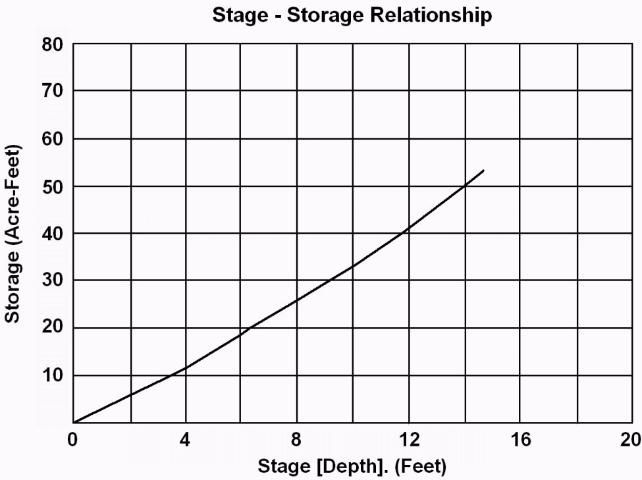
Excavated ponds are generally constructed uniformly so that calculation of surface area and storage is simplified. For example, Figure 2 shows the plan and profile views of a rectangular shaped pond. Surface area can be determined by multiplying the length times the width of the water surface. The width (W) or length (L) of the water surface at any depth (D) can he determined from the length of the base (B w or B L)and the side slope ratio (Z) from: where the factors are as previously defined.
Storage capacity of excavated ponds does not vary linearly with depth, unless the sides are vertical. The storage capacity or volume (V, Ac-ft) at any depth (D, ft) can be calculated by using the two base lengths (B w and BL, ft) and the side slope ratio (Z) as:
It is important to keep the base lengths and depth in units of feet, then storage volume will be in acre-feet. Table 2 can be used to determine base lengths from known surface lengths or vice-versa by keeping in mind that the base length will always be smaller. Table 3, Table 4, and Table 5 can be used to determine pond storage volumes for selected base lengths and depths with side slope ratios of 1:1, 2:1, and 3:1, respectively.
Pond Maintenance
Proper management of the pond can insure good life and service from the pond. Timely maintenance can prevent expensive repair costs.
The sides of the pond should be maintained in a stabilized condition to avoid erosion. Compacting and seeding the soil with a hardy grass seed works well. The grass should be perennial and able to withstand short term periods of excessive or deficit moisture. Bermuda and Bahia grasses work well for Florida conditions. Rainfall can erode bare areas. Therefore inspect the pond after heavy rainfall events and fill and reseed exposed rills and gullies. Check to see that wave action does not damage the ends of the pond. Stabilization and protection with rock rip-rap or similar material may he necessary. Spillways should be maintained clear and free of trash at all times to insure proper operation when needed.
Algae blooms can result in depletion of dissolved oxygen. This can result in fish kills and near anaerobic conditions. Some ponds may require periodic aeration to prevent this from occurring. Also some species of fish which feed on algae and other plant matter can be placed in the pond.
Summary
The applications of ponds for use in Florida were discussed in terms of livestock water needs, irrigation uses, aquaculture, fire protection, and recreation. Site selection requires input on the type of pond, size, depth, water source for recharge, and soils. Design considerations for sizing and construction of excavated ponds were discussed, and example design problems were included in an appendix.
References
Baldwin, L. B. and R. R. Carriker. 1985. Water Resource Management In Florida. Bulletin 206. Gainesville: University of Florida Institute of Food and Agricultural Sciences. 16 pp.
Butson, K. D. and G. M. Prine. 1968. Weekly Rainfall Frequencies In Florida. Circular S-187. Gainesville: University of Florida Institute of Food and Agricultural Sciences. 41 pp.
Harrison, D. S., J. F. Gerber, and R. E. Choate. 1974. Sprinkler Irrigation For Cold Protection. Circular 348. Gainesville: University of Florida Institute of Food and Agricultural Sciences. 19 pp.
Schwab, G. O., R. K. Frevert, K. K. Barnes, and T. W. Edminster. 1971. Farm Reservoirs, p. 189–204. In: Elementary Soil and Water Engineering. John Wiley And Sons, Inc New York.
Smajstrla, A. G., G. A. Clark, S. F. Shih, F. Z. Zazueta, and D. S. Harrison. 1984. Potential Evapotranspiration Probabilities and Distributions In Florida. Bulletin 205. Gainesville: University of Florida Institute of Food and Agricultural Sciences. 24 pp.
Soil Conservation Service. 1973. Building a Pond. Farmer's Bulletin No. 2256. United States Department of Agriculture, Soil Conservation Service, Washington, D.C. 13 pp.
Soil Conservation Service. 1984. Ponds And Reservoirs, Chapter 11. In: Engineering Field Manual. United States Department of Agriculture, Soil Conservation Service, Washington, D.C.
Appendix
Examples
- What volume of water is required for a small dairy operation with 75 cows?
From Table 1, dairy cows require 15 gallons per head per day for drinking needs and 20 gallons per head per day for barn needs.
Water requirements:
- Assuming annual replenishment, what size pond would be required for the dairy operation in Example 1?
- What is the area of the water surface of an excavated pond 12 feet deep, with 2 to 1 (2:1) side slopes, and base lengths of 150 and 225 feet?
Use equations la and lb to determine the length and width of the water surface (Table 2 could be used for approximation):
(Note: 1 acre = 43560 square feet)
- A grower wishes to have a pond for irrigation water to be used for frost and freeze protection of 40 acres of cropped area. The irrigation system delivers water at 0.25 inches per hour. The pond is to be sized to hold water for three consecutive freeze nights with twelve hours of protection each night.
Size the pond assuming negligible losses from evaporation or seepage during the period the pond is needed. Also consider two cases: (1) no return flow from surface runoff; and (2) 50% return flow from surface runoff.
Case 1:
Use Figure 4 to determine the volume of water required each night.
From Figure 4 the required volume per 12 hour night is 0.25 Ac-Ft per acre. Therefore, for 40 acres the nightly requirement is:
Nightly Requirement: (40 acres) x (0.25 Ac Ft/acre) = 10 Acre-Feet
Therefore, the requirement for three nights would be 30 acre feet. Adding 10% or 3 acre feet for base storage requires a 33 acre-foot pond.
Case 2:
This situation has a similar approach to case 1 except that the second and third days each receive return flow from the previous night's irrigation. A simple table will be used to determine the pond volume requirement.
- The grower in Example 4 has a location where an excavated pond can be constructed with surface lengths of 200 and 600 feet, can be 16 feet In total depth, and has 1:1 side slopes. What storage volume can this pond hold using a 3 foot freeboard?
The following information is entered into Table 4 to obtain the base lengths.
A freeboard of 3 feet allows the water to be 13 feet deep in a 16 foot deep pond. Table 6 can be used to provide an estimate of the pond storage volume. Because the exact dimensions are not available in this table, available values will be used to provide estimates. A water depth of 12 feet will provide an estimate of the 13 foot values, base lengths of 100 and 200 feet will be used to bracket the 152 foot base length, and base lengths of 500 and 600 feet will be used to bracket the 552 foot base length.
For B W = 200, B L = 600, and D = 12; V = 35.76 Ac-Ft
For B W = 100, B L = 500, and D = 12; V = 15.81 Ac-Ft
The extra foot of depth would add some to these storage volume values, so that the actual storage is somewhere between 20 and 40 Acre-Feet. An average value of 30 acm-feet can be assumed.
The following equation can be used to provide a more accurate value for the available storage.
This would not be enough storage for case 1 in example 4 which required 33 Acre-Feet. However, suppose the depth could be increased to 14 feet. What would the extra foot of depth yield in storage?
This extra storage can be obtained by multiplying the depth (1 foot) by the average area of the water surface between 13 and 14 feet. Equations la and lb are rearranged to determine the water surface lengths at the 13.5 foot depth. This rearrangement is as follows:
This extra 1 foot of depth would bring the total storage to (31.40 + 2.66) = 34.06 Acre-Feet. Therefore a pond with surface dimensions of 200 ft by 600 ft, 16 feet deep, 2:1 side slopes, and 2 feet of freeboard would be sufficient for the 33 Acre-Foot requirement of case 1 in example
- A rectangular excavated pond with base lengths of 100 ft and 400 ft, and 1:1 side slopes is to be used for irrigation purposes. The pond has a current water depth of 6 feet and must be recharged to a 12 foot depth with water from a nearby well. How much water will the recharge require, an how much time is required to recharge if the pump from the well delivers 1100 gpm?
The required volume of recharge can be determined using Table 3 with the following information:
Figure 3 can be used to convert this value to its equivalent in gallons. A volume of 6.80 Acre-Feet is approximately equal to 2,200,000 gallons. Therefore the time required to supply this volume at 1100gpm is:
Storage volume (V) for rectangular excavated ponds with side slopes of 1:1, Z = 1. Selected base lengths (BW and BL) and depths (D) are presented.
Storage volume (V) for rectangular excavated ponds with side slopes of 2:1, Z = 2. Selected base lengths (BW and BL) and depths (D) are presented.